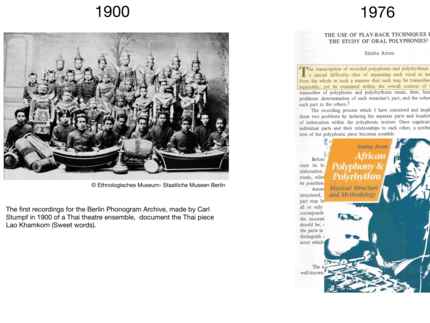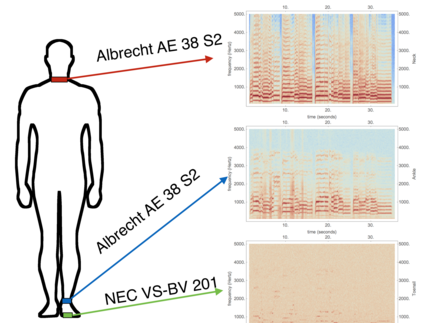Using Larynx Microphones For Recording Of Singing Voices
One of the great challenges for the analysis of polyphonic vocal music from ethnomusicological field recordings is the separation of individual voices in such a way that the natural singing context, e.g. the ways in which singers interact physically, is maintained. Since the early days of ethnomusicological recording practice, this has been a largely unsolved problem. A simple but in terms of quality often insufficient workaround was to let musicians play alone as well as in the ensemble. This has been exercised as far back in time as to the first phonograph recordings by Carl Stumpf in 1900 (left panel of figure on the left side). Naturally, the isolated recording of a musician in this setup can become rather different from the contribution of the same musician in an ensemble. In the context of his pioneering study on African polyphony and polyrhythm done in the second half of the last century (right panel of figure on the left side), Simha Arom developed an ingenious re-recording technique with two tape recorders which allowed him to preserve the ensemble context using technical means. This method is already very close to what later would become known as multi-track recording practice, in which musicians perform to playback tracks of their co-musicians. However, for singers whose natural performance practice involves close physical contact such, the results of singing to a playback and singing with other singers can still be very different, in particular in terms of the harmonic interval contents of the music.
Frank Scherbaum's first encounter with traditional Georgian vocal music as an amateur singer was during a singing workshop by Frank Kane in 2011. As a trained seismologist, Frank Scherbaum was particularly intrigued by Frank Kane ́s way of using vibrations in his voice work and his concept of singing as “vibrational sharing”. Having worked with waves and vibrations for most of his professional life, he immediately started to wonder about the physical aspects of body vibrations. Soon after their first meeting, the two Franks jointly undertook some “seismologically inspired” experiments to quantitatively investigate the generation of body vibrations during singing (Scherbaum et al, 2015; Kane and Scherbaum, 2016). It soon became obvious that with modern high fidelity sensors (e. g. bone and larynx microphones) body vibrations during singing can be recorded all over the body (Scherbaum, 2016). See also figure on the right. Motivated by the results of these initial experiments, Frank Scherbaum went to Georgia in 2015 for a first feasibility field study to investigate the potential of body vibration recordings for ethnomusicological research.
Among the first recordings which were made during that expedition was a recording of the Svan song Elia Lrde, sung by the three eminent singers Islam Pilpani (left), Gigo Chamgeliani (middle), and Murad Pirtskhelani (right). The video captures the beginning of this song.
The video shows the output screen of the TONY program (Mauch et al., 2015) resulting from the analysis of the larynx microphone recording of Islam Pilpani who sings the middle voice in the video above. The black line corresponds to the pitch track while the blue horizontal rectangles correspond to the note objects determined by TONY. Note that even for the polyphonic part (yellow shaded), only the larynx microphone recording is audible and visible. This demonstrates the high quality of the voice separation using larynx microphones.
The most important lessons learned during that pilot study were that indeed recordings of body vibrations using larynx (throat) microphones significantly facilitate an undistorted documentation of the contribution of each singer while all of them are singing together in their natural context (Scherbaum, 2016).
Motivated by the success of the pilot study, in the summer of 2016 Frank Scherbaum and Nana Mzhavanadze performed a three-month field expedition in Svaneti, Georgia to systematically record a new research corpus of traditional Georgian singing, praying, and lamenting using conventional equipment together with larynx microphones. The resulting corpus comprises audio material for more than one hundred songs including more than one thousand audio tracks based on different types of microphones (headset, larynx, ambient, directional), video recordings, as well as written documents of extensive interviews with the performers. In particular, the systematic use of larynx microphones, which has never been used before on a larger scale in ethnomusicological field expeditions, opens up new avenues to apply computational methods for studying tonal aspects and the interaction between singers in polyphonic singing (Scherbaum et al., 2018a, b, 2019)
A selected subset of these recording can be accessed via the accompanying website for the Late-Breaking/Demo "Throat Microphones for Vocal Music Analysis" at the ISMIR 2018 conference (Scherbaum et al., 2018).
Too interesting to be restricted to ethnomusicological field work
Recently, recordings of singing voices with larynx microphones have also been experimentally applied in contexts other than ethnomusicological field work, e.g. during the 2019 Dagstuhl seminar on Computational Methods for Melody and Voice Processing in Music Recordings , organised by Emilia Gómez, Meinard Müller, and Yi-Hsuan Yang, and in Feb 2019 in Susanne Rosenberg's FolkSongLab.
Some practical information about the use of larynx microphones with audio equipment
In case you want to work with larynx microphones yourself and want to benefit from our experiences but are to shy to ask, you can look at the attached technical notes which we have prepared about how we now operate them and the minimum technical modifications we have made to the larynx microphones. (PDF)
References
Kane, F., & Scherbaum, F. (2016). Using body vibrations for teaching, visualization and analysis of traditional Georgian singing. 8th International Symposium on Traditional Polyphony, 26–30 Sept, 11 pp. (PDF)
Mauch, M., Cannam, C., Bittner, R., Fazekas, G., Salamon, J., Dai, J., Bello, J., and Dixon, S. (2015). Computer-aided Melody Note Transcription Using the Tony Software : Accuracy and Efficiency. In Proceedings of the First International Conference on Technologies for Music Notation and Representation.
Scherbaum, F., Loos, W., Kane, F., & Vollmer, D. (2015). Body vibrations as source of information for the analysis of polyphonic vocal music. In Proceedings of the 5th International Workshop on Folk Music Analysis, June 10-12, 2015, University Pierre and Marie Curie, Paris, France (Vol. 5, pp. 89–93). (PDF)
Scherbaum, F. (2016). On the benefit of larynx-microphone field recordings for the documentation and analysis of polyphonic vocal music. Proc. of the 6th International Workshop Folk Music Analysis,15 - 17 June, Dublin/Ireland, 80–87. (PDF)
Scherbaum,F., S. Rosenzweig, M. Müller, D. Vollmer, and N. Mzhavanadze (2018). Throat Microphones for Vocal Music Analysis, in Demos and Late Breaking News of the International Society for Music Information Retrieval Conference (ISMIR), 2018. (Link)
Scherbaum, F., & Mzhavanadze, N. (2018a). A new archive of multichannel-multimedia field recordings of traditional Georgian singing , praying, and lamenting with special emphasis on Svaneti. LaZAR-Database. (გამოქვეყნდება 2018 წლის ბოლოს) (Link)
Scherbaum, F.,Mzhavanadze, N. & E. Dadunashvili (2018b). A Web-Based, Long-Term Archive of Audio, Video, and Larynx-Micro- phone Field Recordings of Traditional Georgian Singing, Praying and Lamenting with Special Emphasis on Svaneti. 9th International Symposium on Traditional Polyphony, 30 Oct - Nov.3. (PDF)
Scherbaum, F., Mzhavanadze, N., Rosenzweig, S., & Müller, M. (2019). Multi-media recordings of traditional Georgian vocal music for computational analysis. Submitted to 9th International Workshop on Folk Music Analysis, 2-4 July, 2019. Birmingham. (PDF) (Video)


